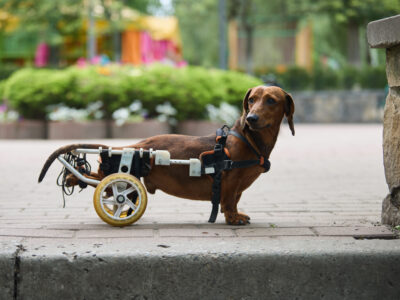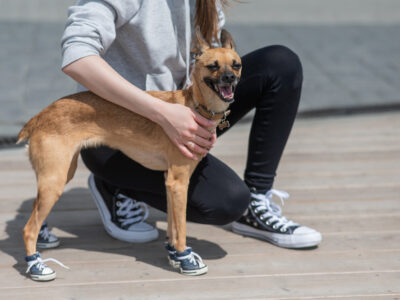I recently learned that heatstroke in dogs is more common than you think. It happened to Olivia, my beagle, when my family decided to go to the park for a picnic dinner. The temperature had cooled down for our human needs, but not enough for Olivia.
Table of Contents[Hide][Show]
We parked ourselves on the cool lawn, but within a few minutes we could see that Olivia was having trouble breathing. The hot, humid air was too much for her. All she could do was lie flat on her stomach and breathe heavily.
My husband and I offered her cool water to drink, but it wasn’t until I brought her into the air-conditioned restroom that she started to breathe easier. We cut our picnic short and headed home.
Olivia recovered quickly once we got her home and into the coolness of the house, but we won’t be doing anymore outings until the temperature is much cooler.
The event reminded me about a previous summer when I was at our veterinarian’s clinic. A man came rushing in with a small, unconscious dog in his arms. It was a hot August day, and they had been driving home from Southern California to Nevada.
The man frantically told the vet that his dog was in the back seat during the trip and that the air conditioning had been running at full blast. Unfortunately, the beating sun had been stronger than the air conditioning.
I don’t know how their story ended, but that’s when I realized that dogs are highly susceptible to heat stroke.

Note: Some of the links in this article are affiliate links. As an Amazon Associate, I earn from qualifying purchases.
Understanding heatstroke in dogs
Heatstroke is a serious and potentially fatal condition, where a dog’s internal temperature gets too hot. A dog’s normal temperature is 101.5 degrees Fahrenheit (F). When it rises to 105 degrees F, your dog is suffering from heat stroke.
Unlike humans, dogs can’t sweat to cool down. They cool themselves by panting, which may not be effective enough in extreme heat.
Early signs of heatstroke
Like Olivia, the first signs of heatstroke were heavy panting and breathing fast. Some dogs also drool, have bright red gums and a fast heart rate.
Progressive symptoms
As heatstroke progresses, the symptoms get more severe. These include problems with balance, gums that go from bright red to pale pink, white or blue. Dogs also have a drop in blood pressure, tremors, collapse and go into a coma.
Are some dogs more susceptible?
Heatstroke can happen to any dog breed, but those with thick undercoats or longhair are more susceptible. The problem also strikes brachycephalic breeds (dogs with short noses) more often.
Very young dogs, very old dogs and canines who are overweight or out of shape are also prone to developing heatstroke.
And sadly, the highest rate of victims are dogs who are left in a car, or crate without access to fresh air or water. The temperature around them can soar after only a few minutes.
Special consideration for dogs with mobility problems
High temperatures can exacerbate existing health issues and make dogs more vulnerable. This is true for dogs with mobility problems and especially for pups with paralysis who can’t feel the changes in their body. It’s best to keep your dog inside in an air-conditioned home during the heat of the day.
If your dog has to be outdoors, make sure they are protected with shade, plenty of cool water to drink and soaking in a shallow, portable pool.
If you think your dog has heatstroke, take him to your veterinarian, as soon as possible.

Get the Essential Guide
The Essential Guide of Products for Handicapped Dogs e-book is a labor of love for me. I wrote it to answer your most pressing questions about where to find the best products for your wheelchair dog. You’ll find products you didn’t know existed and each will improve your dog’s quality of life. Print a copy and keep it by your side.
Cooling mats and cooling vests to reduce heatstroke in dogs

Dog cooling mats, pads, beds (or however you want to call them) are a revolutionary new way to keep your pet cool during the summer. They’re great if you live in a warm part of the country.
The mats use water or a non-toxic gel that last 5-7 hours of cooling comfort.
When your dog gets up from the pad, the material pushes the hot air out and allows the surface to return to a cool temperature. They’re great for outings during the summer and creating a cool bed for your pup to sleep at night. Pet owners also like them because the mat rolls up for easy transporting.
The only downside of the cooling mat is its vulnerability to being “chewed.” While most of the pads are made from sturdy materials, the pad can be torn by an aggressive chewer.
Two of my favorite cooling mats for dogs
Arf Dog Cooling Mat
The Green Pet Shop Dog Cooling Mat

My favorite harnesses for disabled dogs.
Dog Cooling Vests
If your dog doesn’t like to lie down to keep cool, a dog cooling vest could be a better solution. They are lightweight dog vests that you fill with cold water or ice packs to keep your dog refreshed in the heat.
The vest works by keeping the cool air against your dog’s body and letting the warm air evaporate away. Dog cooling vests are made from sun protective materials, have easy to release buckles and can attach to a leash.
Once the water or ice has evaporated, you can restart the cooling process again by adding more water or ice to the vest.





Leave a Reply